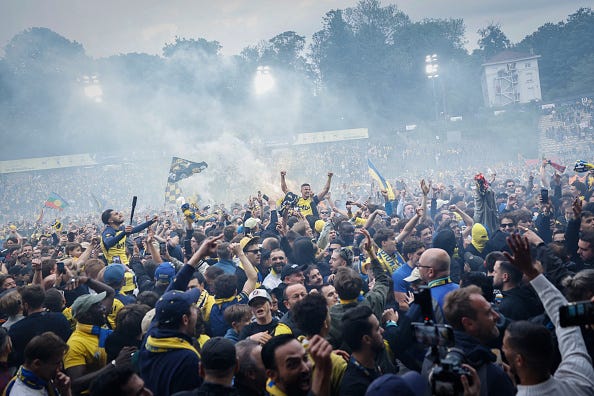How the extraordinary recruitment behind Belgium's new champions could predict a revolution at Hearts
Union SG just won their first title since 1935 powered by the same talent ID and data machine that Tony Bloom wants to install at Hearts
Royale Union Saint-Gilloise, aka Union SG, were once the most successful football club in Belgium. Founded in 1897, they won the league for the first time in 1904, and their 11th in 1935, and ever since then it’s been one long wait for more title glory.
That wait is now over, after they bagged the win they needed to seal the Belgian title on Sunday evening, beating Gent 3-1.
Their fortunes have been transformed since May 2018, when Tony Bloom, 55, became the majority shareholder at Union SG.

His friend and business partner Alex Muzio, 41, who spent years working at Bloom’s StarLizard data business, has been majority owner since 2023, and was chairman before that. That restructuring had to happen because Bloom could no longer own majority shares in two clubs, Brighton and Union SG, who might have come up against each other in the 2023-24 Europa League.
Do you know Nutmeg also produce a print magazine full of brilliant football stories
like this one? Issue 36 is out this week - click here to discover more
We’ll move on shortly to the youthful and innovative executive set-up that Bloom put into place after arriving in Brussels in 2018. Suffice to say they have had roaring success, on and off the pitch.
That is now especially relevant to Scottish football as Bloom waits for an imminent decision on whether Heart of Midlothian will accept his offer of an investment of £9.86million for 29% of the club.
A consultation period with the club’s majority shareholders — the Foundation of Hearts — has been underway for weeks and a vote is expected imminently.
As we reported on this site back in October, the almost £10m in funds will clearly be important, if the deal goes through, but arguably more exciting for Jambos and the wider Scottish game is seeing whether Bloom can do with data what he has already done at Brighton and Union SG.
It’s the top-secret talent-spotting algorithm and best-in-class data that has underpinned the transformation at both clubs.
Player acquisition and trading have been central to both and today we’ll dig into the particulars of how Union SG have operated over the past seven seasons.
As recently as 1997-98, Brighton finished 23rd in the fourth tier of the English football pyramid, just one place above Doncaster Rovers, who were relegated to the non-league.
Some rollercoaster years in the Noughties saw the Seagulls rise and fall from the fourth tier to the second-tier Championship and back to the third-tier League One.
Union SG have also had their own trip down to the fourth tier before the remarkable re-shaping of the club under Bloom and Muzio, and before we get into the strategies that have worked for Union — and might indeed work at Tynecastle, I will:
Recap Union SG’s sorry fall from grace after 1935.
Detail the key five-man executive team who have transformed Union SG, including the hands-off Bloom and the hands-on Muzio, who commutes to his club on the Eurostar from his home in London.
Explore how taking punts on players that other clubs wouldn’t risk have, in some cases, paid off spectacularly.
Detail how the Union SG transfer policy in the last three years in particular has had considerably more hits than misses, with many players fitting straight into the system and increasing their values accordingly.
Keep reading with a 7-day free trial
Subscribe to Nutmeg FC to keep reading this post and get 7 days of free access to the full post archives.



